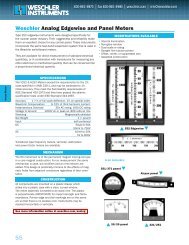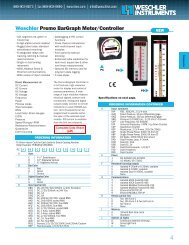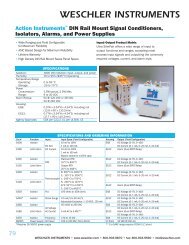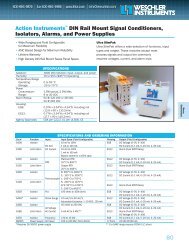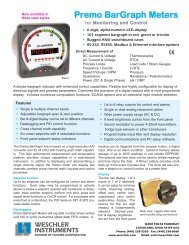WWW.MEGGER.COM
A practical guide to earth resistance testing - Weschler Instruments
A practical guide to earth resistance testing - Weschler Instruments
You also want an ePaper? Increase the reach of your titles
YUMPU automatically turns print PDFs into web optimized ePapers that Google loves.
Supplementary TestsThere are related tests which can be performed to supplement theinformation gained from the ground test and to augment the protectionprovided by the ground electrode. One of these is a continuity test toassure that it is complete and adequate throughout the groundingconductors and down to the point of contact with the electrode. Eithera three-terminal or four-terminal tester can be used in a two-terminalconfiguration by shunting together the appropriate pairs. The two leadscan thus be connected across a bond, weld, joint, or length of conductor,and the resistance measured. An earth tester, however, provides only aconvenient backup check, not a fully rigorous continuity test. The reasonfor this is that, for safety’s sake, the test current is limited to values belowa level harmful to the human body. A fully rigorous proof of a bond,however, must stress the connection at current levels capable of revealingcorrosion, cracks, loose connections, and the like. For this reason, adedicated low resistance ohmmeter capable of 10 A or more of testcurrent is preferred.How to Improve Earth ResistanceWhen you find that your earth electrode resistance is not low enough,there are several ways you can improve it:n Lengthen the earth electrode in the earth.n Use multiple rods.n Treat the soil.Effect of Rod Size: As you might suspect, driving a longer rod deeperinto the earth, materially decreases its resistance. In general, doublingthe rod length reduces resistance by about 40 percent. The curve ofFig.15 shows this effect. For example, note that a rod driven 2 ft downhas a resistance of 88 Ω; the same rod driven 4 ft down has a resistanceof about 50 Ω. Using the 40 percent reduction rule, 88 x 0.4 = 35 Ωreduction. By this calculation, a 4-ft deep rod would have a resistance of88 - 35 or 53 Ω — comparing closely with the curve values.To protect personnel about to perform a ground test, as well as to identifythe presence of electrical problems in the system, the ground electrodecan first be checked for the presence of fault current. It is not uncommon,in an unbalanced or faulted electrical system, for the electrode to becarrying a fault current, more or less constantly, to ground. This maybe only a few milliamps or several amps, and occurring undetected. Asufficiently sensitive clamp-on milliammeter can reveal the problem, andprotect the testing crew from possible shock, in just a few seconds.The total impedance of the system can be measured at once by using aloop tester. This instrument simulates a fault between a phase conductorand ground, and thereby measures the total impedance of the entireground loop, including conductors and the earth return path back to thetransformer and its winding. If any of these elements have too high aresistance, protective devices may be inhibited from operating properly,even though the ground electrode itself is maintained at a sufficiently lowresistance. Fig. 15: Earth resistance decreases with depth of electrode in earth (Source: Ref 19)36 1-866-254-0962 www.megger.com Getting Down to Earth 37



